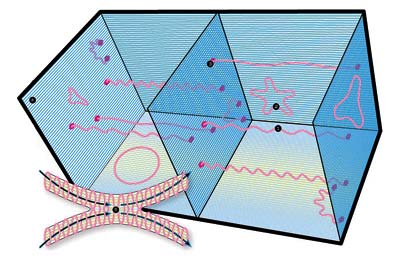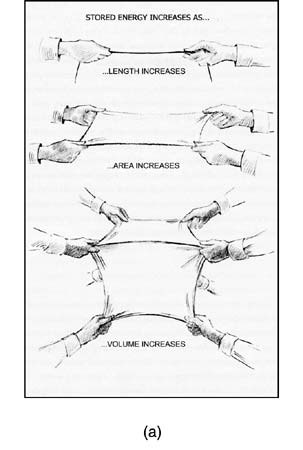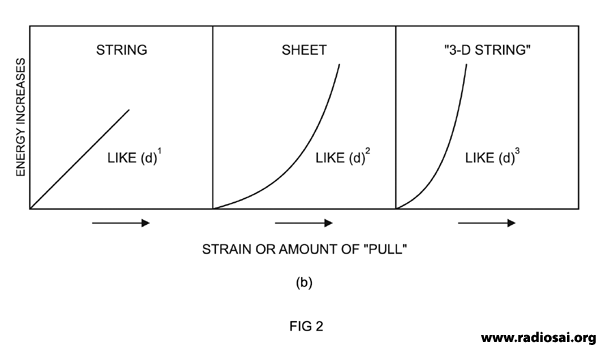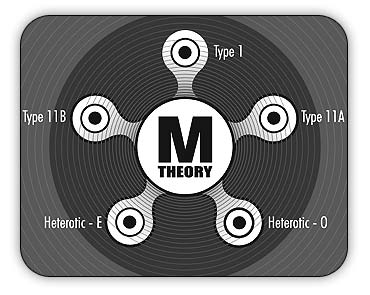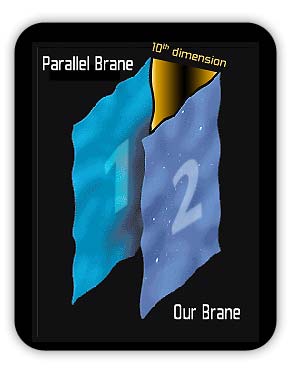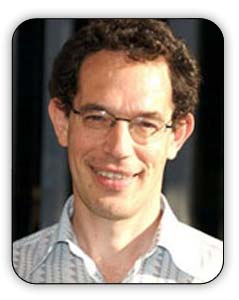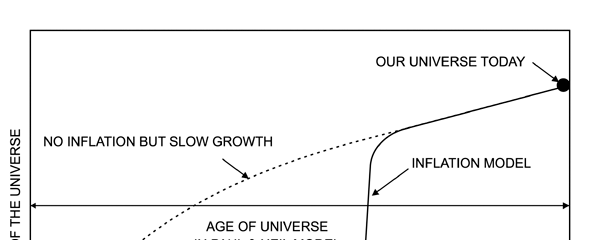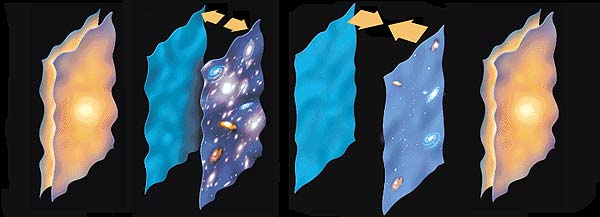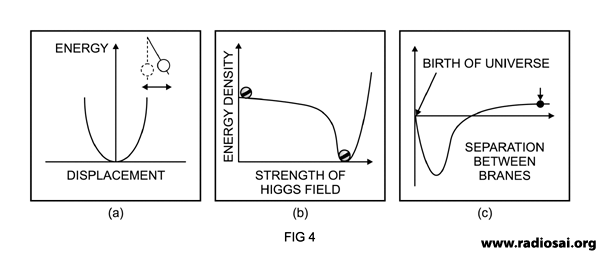 |
 |
 |
Volume
6 - Issue 04
APRIL - 2008 |
IN QUEST OF INFINITY – 15 By Prof. G. Venkataraman
Loving Sai Ram and greetings from Prashanti Nilayam. Our quest for Infinity is taking us on a long journey, is it not? Well, after all it is Infinity we are after, and we should not be surprised if the quest is long! However, as long as the quest itself is exciting, I guess there is not need to feel either tired or bored. With that preamble, let me pick up the threads from where I left off last time.
If you recall, I had, after recalling first the ancient versions of the so-called Cyclic Model of the Universe [which I did in QFI – 13], moved on to a brief narration of how the Cyclic Model came to be revived in the 20 th Century, and how it came to be abandoned after four fatal blows were delivered to it, almost till very recently. And yet, in a sort of never-say-die spirit, the Cyclic Model is refusing to give up, incarnating in a new “Avatar”, taking the help of modern String Theory. I briefly hinted about this development in some of my earlier presentations but this time, I shall go into it in as much detail as we can in these pages. So on now finally to the “New Improved Version of the Cyclic Model, with a Magic Additive called String Theory!” – maybe I could try to sell it that way, just like TV ads try to sell soap and toothpaste! Before I proceed any further, let me assure that I am not about to present a soap opera; on the other hand, this is serious cosmology. Let us go back a bit and start with a sketch that summarises the essence of what people believed in, after the original Inflation Model of the Universe received general acceptance. This schematic may be seen below; along with this schematic, I also offer another that captures similarly the essence of the original Cyclic Model [pre Tolman, that is – see QFI – 14].
The Cyclic Model of the Universe - With Strings Attached I also told you in detail last time how, starting with Richard Tolman, four blows were struck on the Cyclic Model. That being the case, one would have thought that the Inflationary Model would now be proclaimed the victor and rule the scene. However, thanks to Paul Steinhardt and Neil Turok, the Cyclic Model is trying to stage a comeback [in a “new and improved form” of course], and the rest of this episode would be mostly about this revival story.
As I have mentioned several times [though only briefly and somewhat casually up to this point], the version of the Cyclic Model that Paul and Neil offer is based on String Theory; and they are venturing to do this because in their view, the Inflationary Model [Figure 1(a)] is not all that faultless. So, before I start describing what exactly Paul and Neil are trying to do, let me remind you of a few elementary facts concerning strings and String Theory. The first thing is that string can acquire tension and store this tension energy. If, for example, you consider a small piece of string that is open and loose, then it would have no tension. However, when pulled, it would develop tension; moreover, the tension grows linearly, that is to say, if the length is doubled, the energy also is doubled. If the length increases three-fold, then correspondingly the energy of tension also is trebled, and so on. [See Figure 2]. Suppose we have, instead of a piece of string, a rubber sheet or membrane; in this case also the energy due to pulling or applying a tension or strain energy as it is sometimes called, would increase. By how much? Well, there is where the thing becomes interesting. If say the sheet is in the form of a square and as a result of the pull, all sides double in length. The strain energy would then not just double but increase four times. It turns out that if we move over from simple strings to two and higher dimensional membranes, the energy increase is proportional to (d)n, meaning the nth power of the dimension of the [generalised] string. Thus, in the case of the ordinary string, the energy increases simply in proportion to (d); in the case of the two-dimensional string or sheet, it increases as (d)2. In the case of the three-dimensional string, the energy increase follows the rule (d)3, and so on; hope that is clear.
Now why am I telling you all this? Just to convey two important facts: The first is that if we want an efficient energy reservoir, then we should consider strings of higher dimensions or branes. The second and the related fact is that developments in String Theory do offer scope for considering branes, rather than just simple strings themselves. Initially, hardly anyone even thought of connecting String Theory with Cosmology; there were problems in the theory itself, which, let us remember, was still in a rudimentary stage. One problem was that there seemed to be so many versions; the question was: “Which one of these was to be taken seriously?” Then came Witten, who, waving a magic wand as it were, assured the community that though there appeared to be diversity, there was really a basic underlying unity – I described this in QFI – 10. [Reminds us of Swami’s saying, “Jewels are many but gold is one”, does it not?]
Soon after the Witten magic, many thought, “Maybe, we can use the M theory and explain inflation. If we do that, then inflationary cosmology would have a foundation in fundamental physics.” There was great excitement in the air, even as many worked hard to get there first. But then came the bad news and the crash – the M theory, if invoked to explain inflation, did predict inflation but the inflation happened too fast. By this I mean the universe after inflation had too many wrinkles and it was not smooth by any means, which went against experiment. In Physics, experiment always has the final say; if its vote is negative [meaning the experiment comes up with a result that does not agree with theory], then out goes the theory, no matter how distinguished and famous the author is! Well, that is exactly what happened in this case, though there were no star competitors. Physics and Cosmology Attempt to Agree That was one down for M theory, no entry into cosmology, at least right then. We move on now to the late 1990’s when a scientific meeting was arranged at the Newton Institute in Cambridge, [recall QFI – 12 where I discuss the birth of this Institute]. The main aim of this particular meeting was to bring leading string theorists and cosmologists together to the same venue, hoping that proximity and stimulating talks would induce the two communities to break new ground by coming up with innovative ideas. That indeed happened.
It all started with a talk by Burt Ovrut, a highly respected string theorist and a colleague of Paul Steinhardt during the latter’s stay at the University of Pennsylvania. Ovrut who was not only a good physicist but also blessed with artistic talent, made his talk come alive with evocative drawings and sketches, even as he explained complex ideas. Ovrut started by reminding the audience that space in string theory is multi-dimensional [see QFI – 13]. He then drew on the board, two close sheets that were close and parallel. Although the sheets shown in the sketch were two-dimensional, Ovrut asked the audience to imagine that these two-dimensional sheets really represented nine-dimensional space. [By the way, in Physics and cosmology too, we must consider not only space but also time, which, by the way, has the status of a dimension, though of a different type. Here, for simplicity, we keep the time aspect out.] Are we not missing something here? Is not the Witten theory supposed to have ten space dimensions rather than nine? Sure there are ten space dimensions in all and we are not forgetting the tenth dimension. Ovrut said that the gap between the sheets lies along the tenth dimension. In other words, the gap represents the tenth dimension of sheet 1, and it also represents the tenth dimension of sheet 2 (at right). Ovrut added something more. He said that the sheets [which, remember are really branes], are not ordinary ones. Branes normally have space on both sides [this sentence may sound confusing; if it does, think of it this way: branes are like “carriers” for space dimensions]. But Ovrut’s branes were special; they represented the boundaries of the tenth dimension. Put this way, space [taking all dimensions into consideration] exists only on one side of the two branes and between the two branes; the side of the brane that is chosen, faces the gap. I am aware that all this is a bit difficult to grasp [and also maybe to swallow!]. To repeat,
This is the starting picture of Ovrut. Why does Ovrut want this other parallel brane? What purpose does it serve? Why is he not satisfied with just one brane? According to Ovrut, the proximity of two such brane worlds could lead to spring-like forces between the two branes, and as a result, the branes could move back and forth. Could they collide? Maybe! Could the collision produce a Big Bang? Perhaps!
So you get the idea, don’t you? Bringing in branes and all that, even opens up the possibility of explaining why the Big Bang occurred! Wow!! However, things are often not that simple in Physics; it is one thing to get a bright idea but quite another to work out the details mathematically. And physicists are pretty hard-nosed people who don’t accept mere handwaving! If you have an idea, you must first spell out all the details mathematically and give a framework that enables people to do their own calculations and make predictions. After that, one waits for experiments; and that is when the jury is out. After that the final outcome; do the experiments agree with experiments or not? If they do not, then out goes the theory, no matter how beautiful and elegant it is mathematically and how famous its author! In this case, the mathematics of the colliding branes, at least the first cut, proved too tough. And that is how the curtain came down on scene 1. Great Minds Struggling with Gigantic Theories The curtain rises again, this time on scene 2, which begins in a train going to London from Cambridge. Time: The evening of the day when Ovrut gave his talk. Three people are riding the train, all going to London for the same purpose, to attend a play there, which was supposed to be a part of the cultural program associated with the heavy scientific discussions – major conferences and seminars always throw in some event meant to promote relaxation; often it is a party [and I guess you understand what that means!] but in this case, Cambridge being a high-brow place, the organisers just gave the participants tickets to a high class play then running in London. Huddled in the train speeding to London were Paul, Neil and Ovrut. They were lost in discussion, hardly aware of the landscape speeding by. They realised that brane collisions were unavoidable in M theory. Next, a brane collision would in no ways be unique; if there was a collision, then there must have been others before, and that concept had of course, huge implications; it meant – back to the Cyclic Model! What?! How could that be? That model had been killed four times and buried four fathoms deep! However, it seemed that in the M theory, the Cyclic Model could not be dismissed all that easily!
Meanwhile, the train pulled into London, and the brain-storming session had to stop. However, the seeds of a new idea had been sown, at least in the minds of Paul and Neil, and that is how scene 3 begins! Scene 3: Paul and Neil decide to work and do so intensely to see if they could pull something out of all this. Sure it was not easy, but then, exciting problems seldom are. However, history has shown many a time that if one is steadfast, never loses hope and persists in nibbling away at the difficulties the model posed, then one day, one might even hit the jackpot. It was that hope that kept the two going. Paul roped in an associate, Justin Khoury, and the two worked closely, holding daily meetings to discuss progress. Paul and Ovrut also met once a week, though one was in Princeton and the other in Pennsylvania – that was the kind of magnetic pull that the new idea provided. What about Neil? Well, he was on the other side of the Atlantic, sometimes in Cambridge where he had settled, and sometimes in his native South Africa, where he was trying to set up the new African Institute for Mathematical Sciences. Between Neil and the trio in America, there were countless phone calls, e-mails, and faxes, so that everyone was in touch with everyone else all the time. Digressing for a moment, these days, we take all such conveniences for granted; thus, we scarcely appreciate how different it was say in 1900 or, for that matter, even in 1950. We must keep that in mind, when we reflect on the way science developed back then. Scene 4: Something emerges after all this furious tossing of ideas and scribbling hundreds of equations on pieces of paper all the time. The four mentioned above have a model, a model based on M theory, a model that addressed the question of the birth and the evolution of the Universe, our Universe of course. What was the big deal about this new idea, apart from the fact that it relied on M theory to kick off the birth of the Universe? The big deal [schematically illustrated in Figure 3] is that it tries to explain why our Universe is presently the way it is, WITHOUT bringing in inflation. Remember what I said about inflation when I introduced it to you to in QFI – 08? Alan Guth invented the idea of inflation in order to explain why the Universe is pretty smooth and rather flat today, which it would not have been if we had only regular and steady growth/expansion from the moment of the Big Bang.
Now you might wonder: In one of the earlier issues, I told you that recent high precision satellite experiments had suggested that the Inflation Model was right; and now I am telling you that maybe inflation did not occur at all! So what’s going on? Are the physicists spending huge amounts of public money and using it for engaging in a huge con game? Not really. You see, when the satellites obtained some data and the authors of the experiment wanted to know what that data was telling us, they did the obvious and the most reasonable thing. Now typically, when there are new experimental findings, the researchers usually say: “Let us see who has said what about such matters prior to our experiments.” They then study carefully all the earlier predictions made by model builders or “forecasters” if I might call them that, and then say, “Well, it looks like our data are consistent with the predictions made by so and so; however, there are some differences, ……..” and so on. That is the way opinions are generally expressed and conclusions drawn. If there is only one candidate theory available, then that alone is considered while examining the data. That DOES NOT mean that another theory later could not explain all these facts in an entirely different way. Such things do often happen and I shall tell you more about such matters later, when we consider fundamentals of physics needed to consider matter, space and time in their entirety. What I am driving at is that when the satellite results became available, the only model generally accepted was the Inflationary Universe Model; and that was the model the results were compared with, as was to be expected of course. While the satellite experiments certainly were in agreement with many aspects of the Inflationary Model [in so far as they relate to the Universe as it existed after radiation started dominating – see Fig 06 in QFI –09], the satellite data could be equally in agreement with an alternate model [such as we are discussing now] where after about say anywhere between100,000 to 300,000 years after the Universe was born [an event we describe via the word Big Bang], the Universe had the same appearance as it had in the Inflationary Model. As Figure 3 above shows, in one case, this state when the radiation era begins is attained, in the Inflation Model by one burst of super rapid expansion. In the Brane Collision Model now under discussion, this same state is reached via a slower growth stretched over a longer period. The end result [i.e., the state of affairs when the radiation era beings] is the same; what differs is the way the Universe evolves to this era. Is there any way of picking between these two alternatives? There sure is but that would come later.
Let me continue with what I was telling you earlier. While discussing what I called “Scene 4”, I told you Paul and Neil, along with two others, came up with a model for the Big Bang and the subsequent evolution of our Universe, that sought to avoid inflation, and yet be able to describe the Universe the way it is found to be by recently launched satellite experiments. The model was far from perfect but seemed very promising. A Universe of Fire At this point, there arose an interesting issue: what name to give the “new baby”? All kinds of suggestions were made from Big Splat to Brane Smash. However, Paul Steinhardt, who felt that this was too important a matter to be dismissed with some humorous and funny title, sought the help of Greek scholars; as a result, the name Ekpyrotic Model was given to this new idea in which our Universe is born out of brane collision. The Greek work ekpyrosis means that the Universes was born out of fire. And this name Ekpyrotic Model has since stuck.
Scene 5: August 2001. There is a meeting in Rovaniemi, Finland, a small town right near the Arctic Circle. The meeting called COSMOS – 01, brought together cosmologists and particle physicists, and it was at that meeting, that Paul and Neil presented their [draft] paper on the Ekpyrotic Model. The presentation started a heated argument involving, as Paul and Neil recall, “a raucous back-and-forth with a few enthusiasts of the inflationary picture, a snowstorm of silly barbs and minor quibbles. In the end, most of the audience probably left with the impression that the ekpyrotic picture was too exotic and confusing to be considered a serious contender. As the two of us left the auditorium, we were so frustrated by the lost opportunity that we agreed not to exchange a word about what had happened until breakfast the next morning.” Scene 6: Paul and Neil get up next morning, after a sleepless night, in a rather grumpy mood one might add, and mechanically go through the breakfast routine. They then go for a long walk alongside a river in the bright Arctic sunlight. A serious conversation begins. Questions are fired back and forth and the discussion goes like: “No that cannot be right!” “But look at it this way!” “Maybe we could fix that problem doing this!” “You know what? That’s a great idea. You know why? Because we now could do this….” And so on. It is difficult to describe the mood that grips a lively scientific dialogue when very creative ideas get tossed around, but this much I can say with mild experiences of such brainstorming. Suddenly, the cloud lifts and where there was darkness, there is new hope, a feeling of light-at-the-end-the tunnel, and a desire to roll up the sleeves and get back to work. That’s what happened after the long walk in the Arctic Circle. Paul and Neil began to understand why their paper on the Ekpyrotic Model got a reception, that was as cold as the Arctic winter! There were all kinds of conceptual defects, all of which needed a fix. The problem was to find that fix, and in was when they went about that task that the “new improved version” of the Ekpyrotic Model was born! And it is that version 2.0 [which, took shape even as America was shaken by the 9/11 attacks] that I shall now describe in outline, of course glossing over as usual, the knotty and complex details. The key idea is that the two branes that face each other [with the tenth dimension tucked in between] are held together by some kind of a spring-like force. Now elementary physics tells us that if two objects are coupled by a spring, they could move back and forth relative to each other in a period way. The way this is taught to physics students is by drawing a picture of the force or tension that exists between the two entities connected by the spring. While force is what matters for motion, in physics we start with something more fundamental, which is energy [the “mother” of the force]. For the usual spring problem, the potential energy associated with tension varies with separation as sketched below.
In the case of the brane collision, the potential energy curve invoked by Paul and his associates was a bit more complex as we see in Figure 4. If we compare this curve with the usual curve used for the spring problem, there is a substantial difference; this difference has been built in deliberately to take care of many of the subtle nuances of the Cyclic Model [based on brane collision]. However, there is one aspect of this overall curve, that bears resemblance to the usual harmonic oscillator curve; and that part of the curve is crucial for producing a “cosmic dance” of the branes, that leads to the repeated “birth and death” of the Universe. That in brief was how the Cyclic Model was sought to be revived, using branes now [with all their extra dimensions] rather than with just three space dimensions, as the earlier version [see QFI –14] tried. The stage is now set to have a brief glimpse of the ekpyrotic model as proposed by Paul, Neil and others, based on repeated collisions of two branes, locked in an intricate “cosmic dance” as it were. However, that would have to wait till the next issue! Meanwhile, let me say a word two to those who might wonder what has all this really got to with Infinity, if by Infinity we mean God. At the moment, it might seem that the connection if any is rather tenuous. However, when we are finished, you would be surprised how subtly Infinity leaves its fingerprint in the most unlikely places, including in things infinitesimal! All that comes much later. In the meantime, I do hope you are enjoying this quest, even though you might not exactly be able to follow some of the things I am trying to explain. Thank you for your patience and being with me for, let me see, more than one year now? That sure is most encouraging to me! See you again next month. Jai Sai Ram.
|
|||||||||||||||||||||||||||||||||||||||||||||||||||||||||||||||||
Vol 6 Issue 04 - APRIL 2008
|
Best viewed in Internet Explorer - 1024 x 768 resolution. |




